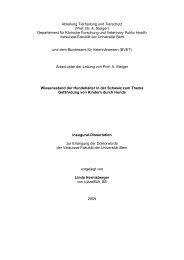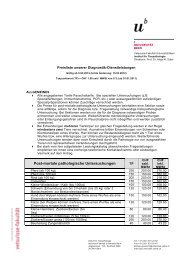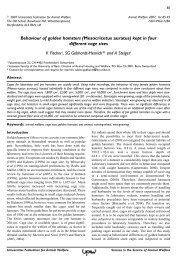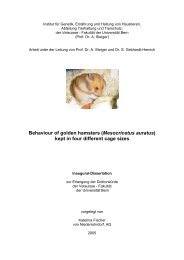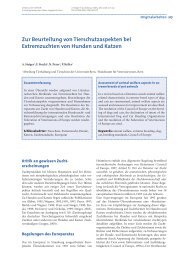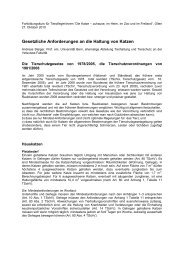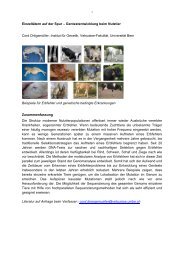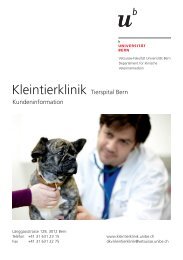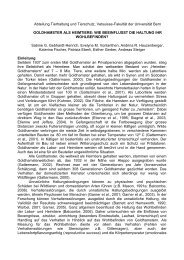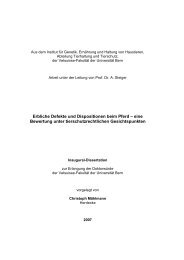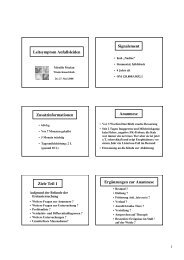Radiographic findings in several joints of nine bears
Radiographic findings in several joints of nine bears
Radiographic findings in several joints of nine bears
You also want an ePaper? Increase the reach of your titles
YUMPU automatically turns print PDFs into web optimized ePapers that Google loves.
dans la plupart des articulations. La prévalence de l’ostéoarthrite se révèle être importante<br />
dans la population d’ours exam<strong>in</strong>ée de cette étude. Cependant, la corrélation entre le<br />
diagnostic radiographique et la cl<strong>in</strong>ique ne se révèle pas toujours évident.<br />
Mots-clé: ours, boiterie, ostéoarthrite, radiographie, zoo, maladie dégénérative des<br />
articulations, vieillissement<br />
Introduction<br />
The conditions <strong>of</strong> keep<strong>in</strong>g wild animals <strong>in</strong> captivity are improv<strong>in</strong>g and the longevity <strong>of</strong> these<br />
animals is <strong>in</strong>creas<strong>in</strong>g. Consequently, management <strong>of</strong> long-liv<strong>in</strong>g species and age-related<br />
diseases are becom<strong>in</strong>g common, some <strong>of</strong> which may be difficult to diagnose and treat, thereby<br />
potentially compromis<strong>in</strong>g welfare. 1 Animals <strong>in</strong> captivity <strong>in</strong>variably live longer than their wild<br />
counterparts. 2-4 There are many consequences <strong>of</strong> old age <strong>in</strong> captive mammals 1 <strong>in</strong>clud<strong>in</strong>g<br />
problems <strong>of</strong> skeleton and teeth. 1,2,5-13 This is also one major problem <strong>of</strong> captive <strong>bears</strong>, because<br />
they usually live a long life <strong>in</strong> zoos. Individuals <strong>of</strong> most bear species may live more than 20<br />
years and for the larger species, some <strong>in</strong>dividuals get till 30 years old and beyond. 14<br />
The care <strong>of</strong> these animals and especially the decision to perform euthanasia <strong>of</strong> geriatric<br />
zoo <strong>bears</strong> is usually a highly complex procedure <strong>in</strong>volv<strong>in</strong>g ethical, medical, emotional and<br />
sometimes political factors.. In old animals, euthanasia has to be considered, but it is very<br />
difficult to evaluate the appropriate time. Besides the medical aspect, the zoo veter<strong>in</strong>arian<br />
must take <strong>in</strong>to consideration the different <strong>in</strong>terests <strong>of</strong> zoo managers and staff, visitors, animal<br />
welfare organizations, sponsors and possibly the needs <strong>of</strong> the respective breed<strong>in</strong>g programs<br />
(e.g. European Endangered Species Program). Consecutive necropsy <strong>of</strong> animals <strong>of</strong>ten shows<br />
that the pathological changes <strong>of</strong> organs and / or the musculoskeletal system are already<br />
advanced. Therefore we hypothesize that the decision to perform euthanasia might be <strong>of</strong>ten<br />
delayed to the detriment <strong>of</strong> the animal’s welfare. The aim <strong>of</strong> this study was to ga<strong>in</strong><br />
radiographic data from jo<strong>in</strong>ts <strong>of</strong> zoo <strong>bears</strong> <strong>in</strong> order to evaluate the <strong>in</strong>cidence <strong>of</strong> osteoarthritis.<br />
The radiographic <strong>f<strong>in</strong>d<strong>in</strong>gs</strong> then serve as one parameter <strong>of</strong> a scor<strong>in</strong>g system to support the<br />
decision mak<strong>in</strong>g for euthanasia <strong>in</strong> geriatric zoo <strong>bears</strong> and zoo mammals (publication <strong>in</strong><br />
preparation).<br />
Material and Methods<br />
Several jo<strong>in</strong>ts <strong>of</strong> n<strong>in</strong>e zoo <strong>bears</strong> (<strong>in</strong> the follow<strong>in</strong>g text numbered from 1 to 9) <strong>of</strong> four genera,<br />
exam<strong>in</strong>ed for health problems, were radiographed. The <strong>bears</strong> live <strong>in</strong> five European zoos. Four<br />
adult brown <strong>bears</strong> (Ursus arctos) (1-4) and one polar bear ( Ursus maritimus) (5) suffered<br />
from lameness and / or gait abnormalities or paraparesis. One sun bear (Helarctos malayanus)<br />
(6) and three black <strong>bears</strong> (Ursus americanus) (7-9) revealed no gait abnormalities and have<br />
been anesthetized for other reasons (Table 1).<br />
36



